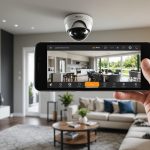Understanding Smart Home Surveillance
Smart home surveillance has revolutionised how homeowners approach security and peace of mind. At the core of smart home surveillance is the ability to monitor one’s home seamlessly through home security systems integrated with modern technology. These systems offer versatile features, enhancing the security of your residence significantly.
A significant benefit of modern surveillance systems is their integration with smartphones. Enabling homeowners to monitor their home environment remotely, smartphone connectivity allows for real-time alerts and live footage viewing from anywhere in the world. This feature keeps homeowners informed and ready to act promptly if any unusual activities are detected.
Also to discover : Transform Your Phone into a Smart Home Command Center: Expert Tips and Strategies
There are various types of smart home surveillance setups available. Popular systems include smart cameras, complete home security packages, and integrated motion sensors. Smart cameras can feature AI technology for advanced recognition, while comprehensive security packages often combine alarms, cameras, and sensors for a robust defence layer. Understanding these options helps homeowners in selecting a system tailored to their specific security needs, ensuring optimal protection and functionality.
Necessary Tools and Equipment for Installation
Successfully installing a smart surveillance system demands the right tools and equipment. Ensuring you have the essential installation tools is crucial, as it impacts the efficiency and durability of the setup.
Also read : Master Home Automation: A Comprehensive Guide to Managing Your Smart Home via Smartphone
Essential Tools for Installation
When preparing for installation, some indispensable tools include a drill, screwdriver, and cable ties. These items help secure your smart camera equipment firmly.
Key Features in Smart Cameras
Choosing the right smart camera equipment involves focusing on several key features. Look for high-resolution imagery and night vision for clear footage at all times. Motion detection is another important feature, enhancing the responsiveness of your system. Cameras with wide-angle lenses can effectively cover larger areas, reducing blind spots.
Recommended Equipment for Optimal Performance
For optimal performance, integrate your system with a reliable Wi-Fi router to ensure consistent connectivity. Selecting a high-capacity storage device is advisable, allowing for extensive video storage without frequent deletions. Additionally, investing in weather-resistant cameras is wise for outdoor installations. These recommendations will ensure that your smart home surveillance system remains effective and efficient, providing peace of mind and enhanced security.
Step-by-Step Installation Guide
Installing a smart surveillance system is straightforward with the right installation guide. Understanding the entire setup process is crucial in ensuring functionality and security.
Preparing Your Space
Begin by selecting optimal locations for your devices. Consider areas with minimal obstructions to maximize coverage. Ensure you have necessary installation tools like drills and screwdrivers. Proper placement aids in enhancing coverage and utility, addressing potential blind spots efficiently.
Connecting the Hardware
In the setup process, ensure all physical connections are secure. Connect smart camera equipment properly, following the manufacturer’s instructions closely. Power cables and data lines should be kept tidy. Secure mounts firmly to avoid angling issues, thereby maintaining an unbroken line of sight for monitoring.
Configuring Smartphone Settings
After physical installation, smartphone configuration is crucial. Download and install the relevant app associated with your camera system. Follow guidelines to pair devices, ensuring that your phone’s Wi-Fi connectivity is robust and secure. Customize alerts for real-time monitoring, setting notifications to flag any irregularities. This detailed configuration enhances the seamless operation of your smart home surveillance system. Prioritizing these steps ensures a smooth installation and optimizes system effectiveness.
Troubleshooting Common Issues
Even the best smart home surveillance systems face occasional hiccups. Let’s tackle some typical challenges you might encounter and how to solve them effectively.
Common Installation Problems
Identifying potential installation issues is critical. For instance, if your smart camera equipment is not powering on, double-check your power source and ensure all connections are secure. Incorrect installation tools used during setup might also lead to hardware misalignment, causing visibility or functionality problems.
Troubleshooting Connectivity Issues
A frequent issue is losing connection to your home security systems. Begin by verifying Wi-Fi strength and ensuring your smartphone monitoring app is up-to-date. Renewing your router settings or relocating it closer to your smart cameras can mitigate connection problems.
When to Seek Professional Support
Sometimes, despite your efforts, problems persist. In cases where system diagnostics become too complex, such as persistent hardware failure or software glitches, it’s wise to seek professional help. Experts have the necessary tools and knowledge to address stubborn issues, ensuring your surveillance system operates smoothly. For consistent peace of mind, regular maintenance and occasional professional check-ups are recommended.
Optimizing Camera Settings
Optimizing camera settings is crucial for achieving the best video quality and enhancing the overall performance of your smart home surveillance system. Adjusting key settings ensures clear footage and responsive detection capabilities.
To start, focus on camera quality by setting the resolution to the highest possible setting your system supports. This adjustment maximises image clarity, allowing for detailed reviews of the footage captured. It’s also beneficial for maintaining the integrity of recorded evidence in case of any security incidents.
Motion detection is another critical area. Enhance system responsiveness by adjusting the sensitivity settings of your motion detection features. Ensure that alerts are customized for different times of the day to reduce unnecessary notifications. This fine-tuning helps in maintaining consistent vigilance while avoiding alert fatigue.
Regular maintenance is essential for optimal performance. Create a schedule to regularly clean lenses and sensors. Dust and grime build-up can degrade image quality over time. Moreover, routinely check for software updates to ensure your system utilizes the latest security patches and features. These practices collectively contribute to a robust and reliable home security system.
Addressing Security and Privacy Concerns
Navigating the complex terrain of security concerns related to smart home surveillance can be daunting. Maintaining robust privacy settings should be a top priority for all users. Tweaking these settings lets homeowners manage who has access to live footage and stored data, which is vital for safeguarding personal information.
Potential security risks often include unauthorized access and data breaches. To fortify your surveillance against such threats, regularly update firmware to patch vulnerabilities. Encryption during data transmission is also essential, ensuring that captured footage remains secure from cyber intrusions.
In terms of privacy settings, always set passwords that are strong and unique, changing them periodically. Moreover, engage the system’s end-to-end encryption capabilities if available, which provides an added layer of protection against hacking attempts.
Protecting personal data involves not just secure storage but also cautious sharing practices. Be selective about sharing access with secondary users, limiting permissions to avoid unnecessary breaches. Monitoring logs for unusual activity on the system provides insight into possible intrusions or unauthorized viewing.
These proactive measures collectively reinforce the security and privacy foundations of your smart home surveillance, offering peace of mind in knowing that both your home and your data are well-protected.
Comparing Different Surveillance Systems
When exploring smart home surveillance, evaluating various systems is vital. This surveillance system comparison enables homeowners to identify the best option suited to their needs. Different systems come with unique features and capabilities, which should be carefully considered during the selection process.
Popular options include systems that integrate with existing home automation, allowing for seamless operations alongside other smart devices. Some systems offer AI technology, providing advanced capabilities like facial recognition or automated alerts. Feature evaluation is essential—prioritize systems with capabilities that enhance usability and security, such as advanced motion detection and high-resolution cameras.
Reviews from other users provide valuable insights into the real-world performance of these systems. Customer feedback often highlights reliability, ease of use, and installation challenges, all critical factors when deciding between surveillance options. Comparisons based on user reviews can pinpoint recurring issues or exemplary performance, guiding a more informed purchase decision.
Ultimately, choosing the right surveillance system involves balancing features with size, budget, and user satisfaction. Consider feedback and comparative features to ensure that the selected system offers ideal protection and functionality for your specific needs.











